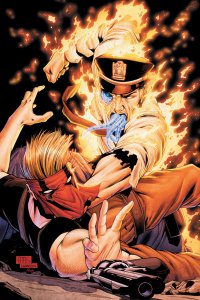 Grifter #1 & 2 (DC Comics, $2.99)
Grifter #1 & 2 (DC Comics, $2.99)
by Graig Kent
While the Wildstorm universe produced some good, and on occasion, excellent comics, unlike the core DC or Marvel Universes, it didn’t really inspire the the same fervent fanbase, but then, really, no other superhero universe has. Now integrated fully into the new DCU, the Wildstorm characters, teams and ideas are given a new life in more ways than one. Grifter, once the “Wolverine” of the Wildstorm universe, is reinvented for the new DC, and while it’s highly unlikely he’s going to reach anywhere near the popularity of old man Logan, he’s already providing some good comics, though excellence may be a touch out of reach.
The first issue was one of my favourites of “The New 52”, perhaps in some small part because of my extremely low expectations and complete disinterest in the previous iteration of character, but moreover due to it just being tremendous damn fun. Cole Cash is an ex-military (black ops, no less) turned con-man who, after a big score, intends to flee to Puerto Rico but has his itinerary interrupted when he’s abducted by aliens. During some sort of consciousness swap, Cole wakes up and escapes, but can telepathically hear the thoughts of every other Daemonite around him, just as they can sense him. This leads to an altercation on an airplane that has Cole wanted as a terrorist by the FBI, and just plain eliminated by his ex-bosses in the military. It’s like if Sawyer from Lost replaced Roddy Piper in They Live with a few extra layers added in. It’s a hell of a pitch anyway.
The second issue scales things back a bit — though it is even more action-packed — letting all that was set up in the first issue settle in with only the slightest nudge forward. Whereas the first issue felt like the opening third of a blockbuster movie, the second feels more like a well-produced action TV show. If you missed the first issue, the second isn’t a bad place to start either.
Writer Nathan Edmondson is relatively new to comics, but a trio of Image titles under his belt in the past two years have given him enough heat to land him at the big two, albeit on a minor character, perhaps as a test to see what he can do with it. It’s evident that Edmondson is less interested in standard superheroics as the book is geared more towards John McClane-style balls-to-the-wall action storytelling, and even though it inhabits the DCU it stays (at least for now) more on the ground level, where the thought of aliens is still kind or bewildering. Characterization does suffer, as it tends to in the genre, but if Edmondson can craft a distinctive personality for “Cole Cash: Action Hero” instead of just the reactionary character he is right now then he will definitely have something worth reading in the long term.
As it stands, Edmondson delivers on entertainment, backed up by the art team of penciler CAFU, inker Jason Gorder and colorist Andrew Dalhouse, who provide a clean, vibrant and utterly attractive looking package. If CAFU wasn’t influenced by Paul Gulacy, I’ll eat the comic, as he shares a truly similar sense of design and usage of light and shadows (his women are less sexified though).
Grifter started off being far better than it had any right to be, and one issue later, it’s easy to see that, while solidly entertaining, there’s plenty of room to be better still.
Rating: 




Out of a Possible 5 Stars
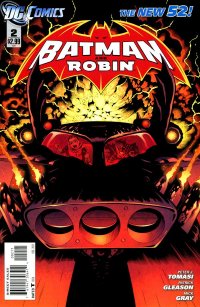 Batman and Robin #2 (DC Comics, $2.99)
Batman and Robin #2 (DC Comics, $2.99)
By Devon Sanders
In DC Comics’ rush to publish, sensationalize & desire to anoint themselves as new industry leaders; they sort of forgot to let folks know they’ll be publishing second issues of their comics. Some have been excellent (Animal Man, Batwoman), some have been good (Aquaman) while others, well… I wish them the best in their future endeavors. Among the titles that truly blew me away was writer Peter Tomasi and artist Patrick Gleason’s Batman & Robin. This comic had it all; an excellent story that sets out to tell the tell of an extraordinary man trying to raise an extraordinary son. It’s illustrated masterfully by an artist I’m sure you’re going to be hearing more about in the very near future and written by a writer known for getting into a character’s motivations. With the first issue, I has instantly hooked. Batman and Robin #2 pulls a “Godfather 2” and out-does the previous issue’s efforts.
Bruce Wayne has made raising his son, Damien Wayne, a priority. He certainly has his work cut out for him as Damian, the new Robin was raised by his mother, Talia to someday become leader of The League of Assassins; an organization created by her father, master criminal, Ra’s al Ghul. As Batman struggles to harness his son’s killer instinct and build a familial bond, The League strikes hard, making moves to take back what they believe belongs to them.
Tomasi and Gleason fire on all cylinders, displaying the synergy they began to cultivate within their Green Lantern Corps run. Tomasi’s writes a Bruce Wayne that who is trying his damnedest to raise a young man. Wayne’s attempts are at times; clumsy, well-intentioned and standoff-ish and at all points, human. I truly found myself truly hoping Wayne can somehow harness the greatest weapon he’s ever created and as soon as I thought this, Tomasi throws in a scene so heartbreaking you’ll almost have no choice but to stick around for the long haul.
Artist Patrick Gleason from the cover on, simply shines. Gleason’s always had a unique eye for layouts and lately has become quite adept in his figure work. Gleason’s figures are things to behold while in action and lately has become quite good illustrating quiet moments. His Damien is full of quiet emotion and Gleason truly seems to get this character most of all.
Batman and Robin #2 is simply a comic with a lot of soul. We need more of this.
Rating: 




Out of a Possible 5 Stars
Avenging Spider-Man Daily Bugle edition (Marvel, free)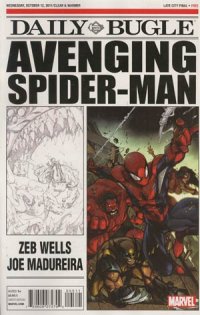
By Jeb D.
As a 10-page trailer for the upcoming new series by Zeb Wells and Joe Madureira, there’s not a lot to this story: Spidey is stretching himself thin between his responsibilities as New York’s friendly neighborhood wall-crawler, and the various Marvel teams he’s on, so this new series will be the latest iteration of a team-up book, pairing Spidey off with other Marvel heroes: in this case, it’s an encounter with the Red Hulk leading into the upcoming first issue. Followers of Amazing Spider-Man will know that Wells has a nice handle on the wisecracking and web-slinging. What’s notable here is that Joe Madureira’s art is several times more appealing than that of his return to comics on The Ultimates. Perhaps he just wasn’t feeling the characters, or the Jeph Loeb scripts, but he’s evidently long nursed a love for Spider-Man, and you can feel his enthusiasm in every panel. This brief teaser just bursts with action and color (much credit to colorist Ferran Daniel) the layouts are exciting and well-populated, but never cluttered (even when hordes of demons descend on the New York City Marathon and engulf poor JJJ), and the brief glimpse we get of the other Avengers (as well as the pencil sketch preview of the next issue) whets the appetite to see Joe Mad take on such promised co-stars as Captain America, Blade, and D-Man(!). For the price, you really don’t want to miss this.
Rating: 




Out of a Possible 5 Stars
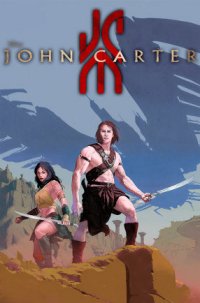 John Carter: World of Mars #1 (of 4)(Marvel Comics, $3.99)
John Carter: World of Mars #1 (of 4)(Marvel Comics, $3.99)
by Graig Kent
The first four pages of this prequel to Disney’s forthcoming John Carter film are an intensive information dump that writer Peter David must have slaved over trying to figure out what to convey, how to introduce the storied history of Edgar Rice Burroughs second-most famous character as well as the film’s spin on it. With only a limited amount of exposure to A Princess of Mars and John Carter, I was trying to determine whom David’s introductory pages were geared towards. Is it for the new-to-Barsoom reader, giving them a taste of the hero they will come to know in the film before veering off into a time before he was a relevant player in the planet’s events? Or is it for the experienced fan of Burroughs’ Mars, easing them into a slightly (or largely?) different world than what they might be accustomed to? Since I’m in between — still relatively new, but not completely without a frame of reference to the world — I found those four pages to be, at worst, clumsy, at best, distracting.
Ultimately what those pages serve to do is provide John Carter a voice as narrator for this tale of events that happened when he wasn’t there. Ah, the anachronistic narrator (for lack of a better term), a pet peeve of mine. I understand that the Mars books (or at least the first of them) were sort of diaries or personal recollections of John Carter’s time on Mars, but having John tell a story that he was absent for, in other words shifting to third person where his voice was typically first person, is an unappealing start.
Getting beyond my own personal annoyance, the book’s purpose, other than to promote the film, is to explore, as its title intones, “The World of Mars”, the different civilizations, their class system, and the conflict between them. Two cities of Helium and Zodanga are long-warring, while the tall, bug-like Tharks are allegorical in many respects to Native Americans at the turn of the 20th century. We get a look at the major players from the film who don’t have their name in the title: the petulant Zodangan prince Sab Than; the beautiful (and atypically modestly dressed, though it is now Disney afterall) Heliumite princess Dejah Thoris; and the Thark warrior Tars Tarkas. While I suppose this is intended to provide us more insight into who these characters were before John Carter traipses in and upends their lives, I don’t really get much out of any of them beyond cliches.
But if the book’s purpose is less to sell this story than it is to sell a forthcoming movie, it does a better job at that, thanks to Luke Ross’ soft, chalk-like illustrations. Though his lines are smudged and shadows faded, Ross seems to be taking great pains to highlight the design work of the film with, as much as his style will allow, plentiful detail. From sets to costumes to weapons, creatures and vehicles, there’s a definite sense of investment and care in the design that is promising for the film to come. Where John Carter was low on my radar before, now I’m keen on digesting the visual delights I’m assuming it will offer based on what Ross showcases here.
It’s hard to rate this book, since it’s obviously a companion piece to a film that isn’t out yet, so I can’t say whether it’s a warranted prequel, fan service, or just fluff. It’s a dull introduction to the whatever story it’s telling, but it looks pretty good telling it.
Rating: 




Out of a Possible 5 Stars
Beyond the Fringe #1A & #1B (DC Comics, $1.99 – digital only)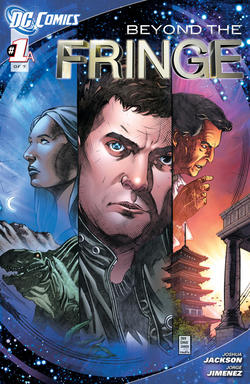
by Graig Kent
DC has been dabbling with digital comics for a while now, notably with their now defunct Zuda line, and even more notably with their bold day-and-date digital availability with their New 52 reboot. But this is a surprise, a bi-weekly major tie-in with a network TV show that’s available in digital format only? One has to guess at the reasoning. Did the previous Fringe comics perform that badly on the newsstands, or does DC think that the Fringe fanbase is more likely to buy things on-line rather than go to a brick and mortar store to pick up the book? Or is it simply they’re experimenting with releasing original comics as digital-only (or digital-first), or is it the format of 14 page books (which, really is 11 pages of story, a cover, a title page and an ad for other Fringe comics) delivered bi-weekly on an alternating basis that is dictating a distribution experiment?
Whatever the reason, it’s very fitting of the Fringe brand to have two different stories running on an alternating basis, since last season was frequently an “Earth 1” story one week, and an “Earth 2” story the next. The difference being that in Fringe Season 3, the stories, while seemingly independent, build upon the larger story that season was trying to tell, while at the same time building the mythology. Here, it’s primarily myth-making, exploring the Fringe universe even further in a context that likely wouldn’t work within the show itself (it would need a Michael Bay-sized budget to pull off issue 1A alone). Needless to say it’s a fans-only affair, but the question becomes is it worthwhile?
The “A” storylin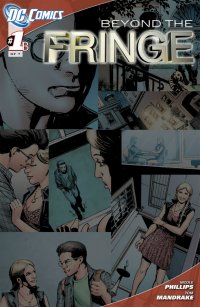 e, written by series star Joshua Jackson (who obviously has the time, given his limited role at the start of Season 4), is subtitled “Peter and the Machine”, a convoluted little tale about Peter Bishop time hopping through the centuries locating remnants of the machine that he and Walter inadvertently scattered across time while trying to change history again, and again, and again. I say it’s convoluted because it’s dense and hard to follow, but at the same time, it’s well written (in Peter’s voice, which naturally Jackson should have a knack for) and seems to have a definite concept or mythology backing it up that should make sense the more the story is revealed. It is, in some respect, Grant Morrison-esque, in the way that Morrison often writes stories knowing the things that happen between panels and before and after the story but refraining from informing the audience (or doing so in a cryptic manner). It’s solidly illustrated from Jorge Jimenez who must contend with multiple time periods and multiple settings including dinosaurs and Romans, and he captures the likenesses of Jackson and John Noble well, so well it’s kind of distracting. It’s not perfect and there is one or two clunky bits (the Roman segment particularly) but it does feel like something meaningful, and relevant to the series at large.
e, written by series star Joshua Jackson (who obviously has the time, given his limited role at the start of Season 4), is subtitled “Peter and the Machine”, a convoluted little tale about Peter Bishop time hopping through the centuries locating remnants of the machine that he and Walter inadvertently scattered across time while trying to change history again, and again, and again. I say it’s convoluted because it’s dense and hard to follow, but at the same time, it’s well written (in Peter’s voice, which naturally Jackson should have a knack for) and seems to have a definite concept or mythology backing it up that should make sense the more the story is revealed. It is, in some respect, Grant Morrison-esque, in the way that Morrison often writes stories knowing the things that happen between panels and before and after the story but refraining from informing the audience (or doing so in a cryptic manner). It’s solidly illustrated from Jorge Jimenez who must contend with multiple time periods and multiple settings including dinosaurs and Romans, and he captures the likenesses of Jackson and John Noble well, so well it’s kind of distracting. It’s not perfect and there is one or two clunky bits (the Roman segment particularly) but it does feel like something meaningful, and relevant to the series at large.
The “B” storyline from writer Nicole Phillips and artist Tom Mandrake explores a “what if” scenario that invokes the idea of not just an “Earth 1” and “Earth 2” as seen on the TV show, but multiple dimensions, such as this one where “Earth 1” Peter didn’t die, Walter went on to invent Windows (not the Bill Gates Windows, but a mass market version of his viewer into “Earth 2”). There are plenty of clever little nods to the show’s past while also, in a very concentrated amount of time, developing a solid speculative fiction world for a very different Peter and even more different Olivia to discover their intertwined fates.
There will be multiple stories throughout the 7 issues (or 14 half-issues) of the series, but if they maintain the quality of these issues and relevance to the series, then it’s a definite pick-up for fans of the show.
Rating: 




Out of a Possible 5 Stars
Orchid #1 (Dark Horse, $1.00)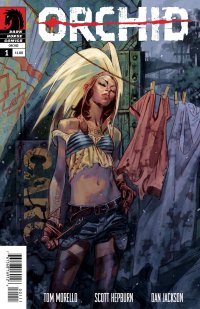
By Jeb D.
We all know that Tom Morello has his heart in the right place: he Rages against Machines, sings songs of workingmen’s solidarity with The Boss, and performs for the Wall Street Occupiers. So it’s not hard to imagine that his idea of a comic would be one that speaks to his fierce impulse toward justice. But as a creator of sequential storytelling, as an architect of an anarchic dystopia, and a writer of convincing dialogue for characters in future-speculative fiction… well, let’s just say he plays a mean guitar.
In a post-cataclysmic world, there is, naturally, a greedy upper class and exploited lower classes. The downtrodden “bridge people” live in rough pre (post?)-industrial villages, are prey to weird monsters (created by evil science run mad, naturally), and dulled into acceptance of their exploitation by commoditized prostitution and leech addiction. Some few still cling to hope in the form of the Shadow Rebels who fight their oppressors, and of their legend of a mask that bestows great power. Our protagonist, a rebel named Simon, survives a bloody failed uprising and seeks refuge by returning to his long-abandoned home with the bridge folk, where he encounters the family of Orchid, a particularly feisty prostitute who runs off after clocking a client who found she was stealing from him (to feed her family, of course). And, wouldn’t you know it—the authorities catch up with both Simon and Orchid simultaneously, hauling them off together in what is actually a fairly grim and bloody romcom-style “meet-cute.” Think sparks will fly between these two?
This comic shares a problem with a lot of these didactic dystopias: Morello is so eager to get on with his indictment of evil that he can’t be bothered to take the time to build his world, so we get torrents of exposition in internal monologue, external monologue (Simon talks to himself out loud more than you’d expect from someone who’s spent years hiding from the authorities), and dialog between characters that serves no purpose within the story context, but is directed solely at catching the reader up on this world he/she has been plunked down in.
There’s an inadvertently revealing note in the backmatter from editor Sierra Hahn, telling us that the world of Orchid “…is not unlike our own if you look closely enough…” Well, there’s your problem right there: in fact, it’s not necessary to look closely at all to see Morello’s anger at our own exploitation of the earth’s resources, its indigenous peoples, and its women, in this “alternate” world. There’s really nothing here that even remotely approaches the level of subtlety we associate with the idea of “subtext”: when female characters forced into prostitution are not only tattooed with the words “PROPERTY” and “KNOW YOUR ROLE” in huge letters, but outfitted in costumes derived from traditional Native American dress, points are being driven home with a sledgehammer, leaving nothing for the reader’s imagination to contribute or be stimulated by.
Having said that, there’s three reasons to buy this book: 1. It’s only a buck. 2. It comes with a link to a free download of a song from Morello’s excellent recent World Wide Rebel Songs album. 3. The art of Scott Hepburn, with colors by Dan Jackson, is terrific. Hepburn’s imaginative paneling moves the story along smoothly, he has a nice cameraman’s eye for perspective, and his pencils have a combination of freshness and polish that I used to associate with guys like Jack Davis or Wally Wood who straddled the worlds of commercial art, newspaper illustration, and comics: he differentiates his characters effectively, with a slightly cartoony quality, and handles the (often quite bloody) action with relish. I’ve seen plenty of comics that would read well enough without the word balloons; this is the rare one that might read better that way.
Whether this planned twelve-issue series will settle itself into sufficiently interesting storytelling to justify spending four bucks (or whatever) on future issues seems kind of doubtful, but it’s certainly worth your spending a hundred pennies to find out if you disagree with me on that.
Rating: 




Out of a Possible 5 Stars
 The Test #1 (Top Cow/Image $3.99)
The Test #1 (Top Cow/Image $3.99)
City of Refuge #1 (Top Cow/Image $3.99)
It’s Dystopia week! Top Cow/Image’s Pilot Season returns with a pair of debut issues that wipe out most of us to follow the weirdly-futuristic-but-really-just-like-us adventures of a core of human survivors of… something.
The Test is a tidy piece of mystery/sci-fi storytelling, with added lashings of horror. A small group of people awaken in a sterile, domed community, and a cheery-creepy holographic projection of a woman informs them that they’ve been asleep for some time: it takes a while for the various characters to recover their voices… and their memories. She then outlines the circumstances of their new environment: they are the chosen remnant of humanity’s survivors of a cataclysmic war, but given that “she” is a pre-recorded announcement, can they rely on her information regarding an apocalypse that hadn’t happened yet? They quickly spot what appear to be discrepancies in the story, while some begin to recover bits and pieces of memory. And this leads, naturally, to discoveries that are shocking and disturbing, both on their face, and for the implications they carry as memories continue to return.
Writer Joshua Hale Fialkov (Elk’s Run, Last of the Greats, I, Vampire) shares creator credit with Matt Hawkins, and his script is sharp and spare, letting artist Rashan Ekedal’s clean, spacious linework tell the story, though he’s another artist whose idea of shadow and drape tends to give skin, hair, and clothing a plasticky sheen. Combined with the muted pastels of colorist Brian Reber, the look isn’t dissimilar to early Invincible—no superheroes (well, not yet anyway), but since the story begins with everyone getting out of bed, the female characters’ outfits wouldn’t look out of place on Emma Frost. I should mention, by the way, that the cover by Bagus Hutomo bears no relation to the look of the comic, and really does it a disservice.
In contrast to the elegant simplicity of The Test, City of Refuge (the title borrowed, I assume, from the recent album by Bela Fleck’s wife 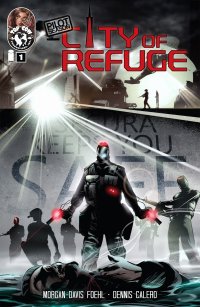 Abigail Washburn) is back in Orchid territory, with a busy, convoluted backstory that needs much exposition before the real story can get underway. In a future San Francisco—a bleak, dark contrast to the way the City By The Bay is usually presented—we get yet another briefing from a smiling face projected on a screen. In contrast to the vague introduction of the unnamed woman in The Test, here, a grinning corporate titan named Robert Vogel gives us a presentation about the behavioral programming that has allowed San Francisco to survive yet another apocalyptic disaster: following the events of “Terminal,” San Franciscans enjoy peace and relative tranquility thanks to “The Program,” which involves implanting an electronic chip called Secura in each person, removing humanity’s natural violent tendencies, replacing them with a sense of communal goodwill. For reasons that aren’t entirely clear, the cops need free will to operate (in a way that, say, power plant engineers or surgeons evidently don’t), so they get to use a drug called Freestone to suppress the effects of Secura. And gosh darn it, somehow Freestone has made its way to the black market (typically, no one in authority is bright enough to imagine this could happen), and as the first issue closes, the consequences are getting gruesome.
Abigail Washburn) is back in Orchid territory, with a busy, convoluted backstory that needs much exposition before the real story can get underway. In a future San Francisco—a bleak, dark contrast to the way the City By The Bay is usually presented—we get yet another briefing from a smiling face projected on a screen. In contrast to the vague introduction of the unnamed woman in The Test, here, a grinning corporate titan named Robert Vogel gives us a presentation about the behavioral programming that has allowed San Francisco to survive yet another apocalyptic disaster: following the events of “Terminal,” San Franciscans enjoy peace and relative tranquility thanks to “The Program,” which involves implanting an electronic chip called Secura in each person, removing humanity’s natural violent tendencies, replacing them with a sense of communal goodwill. For reasons that aren’t entirely clear, the cops need free will to operate (in a way that, say, power plant engineers or surgeons evidently don’t), so they get to use a drug called Freestone to suppress the effects of Secura. And gosh darn it, somehow Freestone has made its way to the black market (typically, no one in authority is bright enough to imagine this could happen), and as the first issue closes, the consequences are getting gruesome.
Our protagonist, Jackson, is (naturally) one of the cops, thus allowing writer Morgan Davis Foehl to take us through a day of activity where every encounter, and every conversation, is an opportunity to pile on more exposition and background. I’m a tad surprised to discover that Foehl’s a film editor by trade, because this is one of those books that is the polar opposite of “Show-Don’t tell,” and much of the dialog makes sense only when you realize it’s being “overheard” by the reader.
His character work is a bit blocky, but Dennis Calero was otherwise a good choice for bringing some rainy noir to San Francisco, though I have to wonder if the story wouldn’t benefit a bit from some visual contrast between the darkness of Jackson’s dreary professional rounds and the “better world” that Vogel’s Secura is supposed to provide to the populace.
As a mystery, City of Refuge feels a bit flat, since we’re already heading into “whodunit” territory (as opposed to The Test, where we’re still intrigued by wondering just what “it” might actually be), and it would require an awfully canny writer to take this story in any direction except that of an eventual nod to the virtues of free will.
Scoring both books, of course, depends a lot on possible future potential. The first issue of City of Refuge is reasonably well executed, but is such an infodump that I really don’t feel there’s much left for me to discover, beyond who’s behind the release of Freestone, and the cynical greed that motivated it There’s no guarantee that The Test won’t ultimately disappoint, but it’s off to a more intriguing start.
THE TEST:
Rating: 




Out of a Possible 5 Stars
CITY OF REFUGE:
Rating: 




Out of a Possible 5 Stars
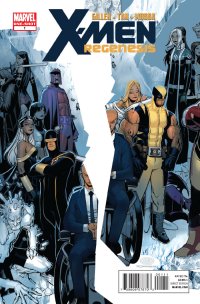 X-Men: Regenesis One-Shot (Marvel, $3.99)
X-Men: Regenesis One-Shot (Marvel, $3.99)
By Jeb D.
If, like me, you’re a casual X fan (assuming there is such a thing), you’d probably be at least somewhat interested in knowing just how the opposing Wolverine/Cyclops teams are going to shape up for the next big X event. But are you excited about the idea of spending four bucks to watch Logan and Scott wander around asking everyone about it? Me neither…
Rating: 




Out of a Possible 5 Stars